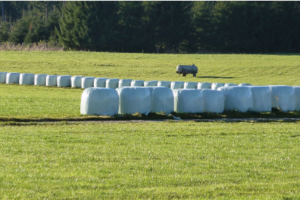In Australia’s vast agricultural landscape, where the harsh climate can challenge traditional farming practices, innovations like silage wrap have emerged as game-changers for livestock farmers.
 Silage wrap, a durable plastic film used to ensile fodder crops, has revolutionised feed preservation, ensuring a steady supply of high-quality feed for livestock year-round. In this article, we delve into the significance of silage wrap in Australian agriculture, exploring its benefits, usage, and impact on the farming community. For more information about the square bale silage wrap, click here.
Silage wrap, a durable plastic film used to ensile fodder crops, has revolutionised feed preservation, ensuring a steady supply of high-quality feed for livestock year-round. In this article, we delve into the significance of silage wrap in Australian agriculture, exploring its benefits, usage, and impact on the farming community. For more information about the square bale silage wrap, click here.
Understanding Silage Wrap
Silage wrap, also known as bale wrap or bale silage, is a specialised plastic film primarily used to package and store silage—a fermented feed made from high-moisture crops such as grass, maize, or sorghum. The process of ensiling involves compacting and sealing the crop in airtight conditions to facilitate anaerobic fermentation, preserving its nutritional value and palatability.
Benefits of Silage Wrap
- Extended Shelf Life: Silage wrap creates an anaerobic environment that inhibits the growth of spoilage organisms, extending the shelf life of fodder crops. This prolonged preservation ensures a consistent and reliable feed supply, which is crucial for sustaining livestock during periods of scarcity.
- Nutritional Preservation: By sealing the ensiled crop from oxygen, silage wrap preserves the nutritional integrity of the forage, retaining essential vitamins, minerals, and proteins. It ensures that livestock receive a balanced diet throughout the year, promoting optimal health and productivity.
- Weather Resistance: Australia’s unpredictable weather patterns, characterised by droughts, floods, and extreme temperatures, pose significant challenges to traditional feed preservation methods. Silage wrap offers superior weather resistance, protecting the ensiled crop from moisture, UV radiation, and microbial degradation, thereby safeguarding feed quality in adverse conditions. For more information about the square bale silage wrap, click here.
- Cost Efficiency: While the initial investment in silage wrap and baling equipment may seem substantial, the long-term cost savings outweigh the expenses. Efficient feed preservation minimises waste and reduces the need for supplementary feeding, resulting in lower overall production costs for livestock farmers.
- Convenience: Silage wrap facilitates convenient storage and handling of fodder crops, allowing farmers to optimise space utilisation and streamline feeding operations. Moreover, its flexibility and ease of application make it suitable for various baling systems, offering farmers greater flexibility in managing their silage inventories.
Silage Wrap Usage in Australia
The adoption of silage wrap technology has increased across Australia’s agricultural landscape, with livestock farmers embracing its benefits to enhance feed management practices. From small-scale operations to large commercial enterprises, silage wrap has become a cornerstone of modern forage conservation strategies.
Furthermore, silage wrap in Australia enables farmers to capitalise on crop residues and marginal lands by converting them into valuable feed resources. Crops unsuitable for direct grazing or haymaking can be ensiled using silage wrap, maximising resource utilisation and enhancing farm productivity.
The versatility of silage wrap extends beyond traditional forage crops, with some farmers exploring alternative feed sources such as grain by-products, vegetable residues, and even recycled food waste for ensiling. This innovative approach not only reduces waste but also diversifies feed options, providing farmers with greater resilience against market fluctuations and input price volatility. For more information about the square bale silage wrap, click here.
The Future of Silage Wrap in Australian Agriculture
As Australia’s agricultural sector continues to evolve in response to changing environmental, economic, and consumer demands, the role of silage wrap is poised to expand further. Technological advancements, such as biodegradable and UV-stabilised films, offer sustainable alternatives that align with the industry’s growing emphasis on environmental stewardship and resource efficiency.
Moreover, ongoing research and development efforts aimed at optimising ensiling techniques, improving film performance, and enhancing feed quality will drive innovation in silage wrap technology. Collaborative initiatives between industry stakeholders, research institutions, and government agencies are vital for fostering knowledge exchange, innovation diffusion, and best practice dissemination within the agricultural community.
Conclusion:
Silage wrap has emerged as a cornerstone technology in Australian agriculture, offering livestock farmers a reliable and cost-effective solution for preserving and managing feed resources.